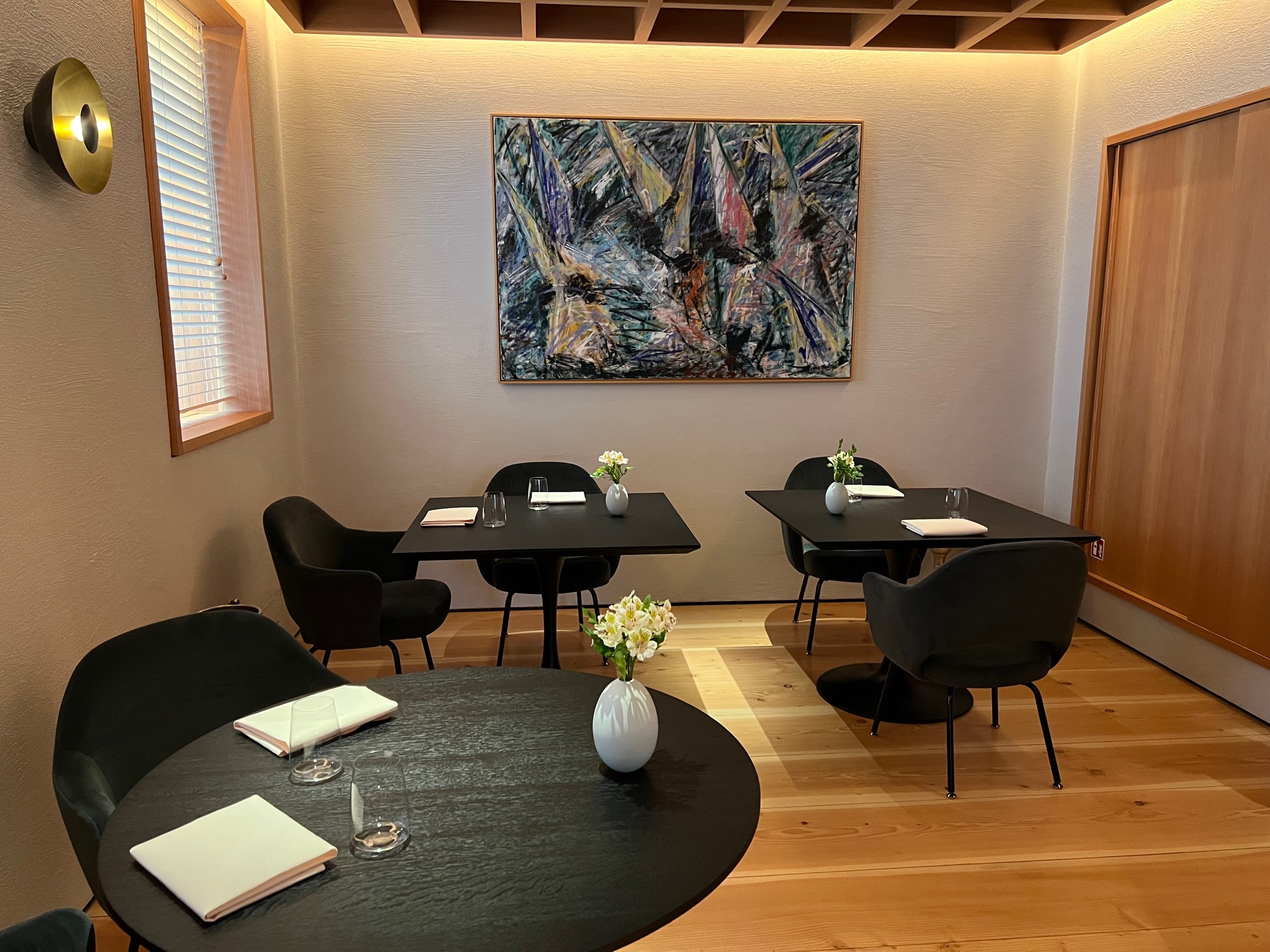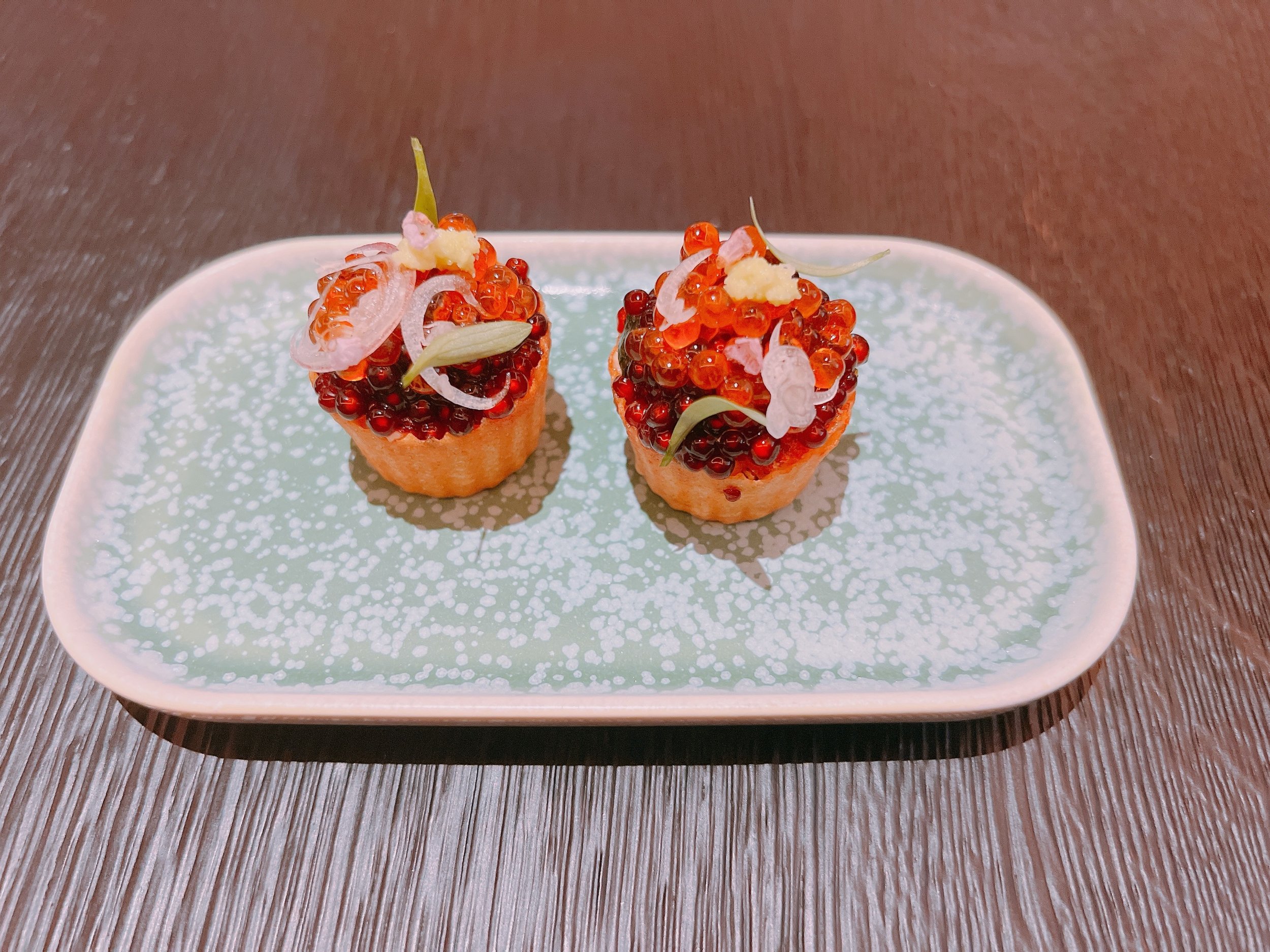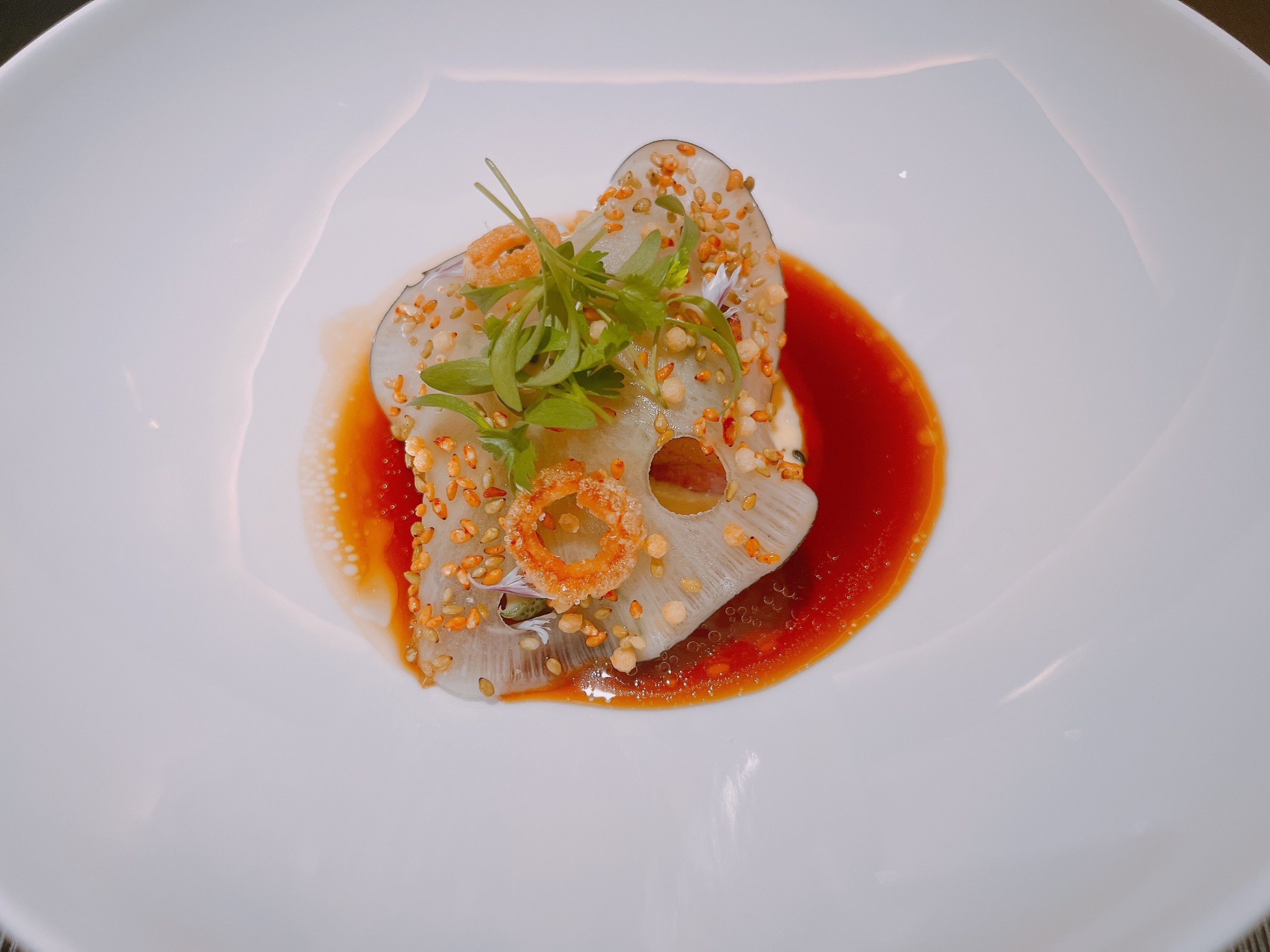JAN - Munich
Rating: 18/20
Where: Munich, Germany
When: Dinner for 2 on 30 June 2023
Cost per Person: Tasting menu 320 Euro, Wine pairing 145 Euro
Accolades: 3 Michelin Stars
Why: Great seafood, some technically amazing dishes
Receiving three Michelin stars only six months after opening a restaurant is almost unheard of. But “JAN”, led by Jan Hartwig, is an exceptional case. Hartwig already held three stars at the nearby “Atelier”, which he left a couple of years ago to open his eponymous restaurant in October 2022. JAN is located a few blocks north of Munich's main train station, so it’s easily reachable for travelers from near and far. The dining room consists of several semi-connected rooms, the largest one with a view of the pass. the others a bit more cramped (to put it nicely). The interior design uses lots of wood, and looks casual enough that one might mistake the dining room for a lounge upon entering. I don't critique interior design, but this one seemed just a little bit dated for a restaurant that opened so recently. We sat in the “backroom” where slatted windows looked out on the office building next door. Tables were spaced quite close to each other, so that with little effort one could listen to neighboring conversations. Luckily, the food was entertainment enough, so eavesdropping wasn't necessary to pass the time.
While the open kitchen is located adjacent to the dining room, sadly there are no tables that have an unobstructed view of it. As mentioned above, the main part of the dining room can at least see the entrance to the kitchen, and the inscription “Labor der Liebe” (laboratory of love) above it, presumably a play on “labor of love”, since in some sense a kitchen can be both, a laboratory (of food) and a labor of love.
JAN serves a single tasting menu for dinner, however it is possible to extend the menu with one or more a la carte “signature” dishes. We chose two such dishes in order to see how they compared to the regular tasting menu. There is a wine pairing on offer as well, with generally good, but not mind-blowing, wines. It is possible to abbreviate the seven-glass pairing by ordering each wine by the glass.
The wine pairing is a good place to mention my main disappointment with our dinner - the service. At no point were we offered the wine list or the option to order the wine pairing. Food was just brought out course by course. I had to proactively wave down our server to finally get a wine pairing after we had reached the point where it was supposed to start. Even after that, paired wines were often poured after the matching food arrived. Needless to say, the sommelier never stopped at our table either. Our request for a second serving of bread was acknowledged, but then ignored - no bread ever materialized. Generally, it was hard to get the attention of the staff, it took us quite a while to signal that we wanted to pay at the end of our dinner. Plus, food descriptions were sometimes given in English and sometimes in German without any rhyme or reason. I think these are all fixable issues, but you wouldn't expect them in a three-star restaurant, and JAN has been open for eight months, so the kinks should have been worked out by now. Hopefully it was just an off night...
After our aperitif, we received a series of amuse bouches. First, a crispy tartlet that was filled with whipped foie gras, capers, caperleaf and pecans. This single bite managed something astonishing: a taste progression. The first impression was the sweetness of the foie gras and pecans, which was then replaced by an umami taste (also the foie), before ending with the saltiness of the capers. Having the flavors change so cleanly is an amazing technical accomplishment. The play between the soft mousse and great crunch of the tarlet was also very nice. When it comes to overall taste, I thought this was merely ok, but there is no denying how hard it is to pull off something like this 18.
The pescatarian alternative for the foie gras praline used candied kombu and an “umami cream”. From the bite I had, the flavor progression was not quite as detailed. Instead, sweetness and umami dominated, and the praline also felt a bit less crunchy overall 18.
Next, we received a bite that was a stack of (from the bottom) lime merengue, fresh sardine, jalapeño mousse and aioli. There was lots going on here, the flavors practically toppled over each other. Sweetness, saltiness, and a hint of spiciness (from the jalapeño), all coming together deliciously. The fish was also very nice - the bite ended with it, since the other pieces dissolved quicker 18.
A little buckwheat tarte was filled with char tartare, and topped with soy sauce pearls, trout caviar, slices of myoga and some freshly grated wasabi. Again a great crunch from the tartlet, and a very nice fish tartare. The soy sauce pearls were maybe a bit too abundant, they made this dish quite salty. Still nice, though 18.
The last amuse bouche was an oyster served “Rockefeller” style. The oyster was cut and mixed with young leeks, a hollandaise made with parsley, and topped with gratinated Gruyere cheese and some decorative chives. I liked the salty and crunchy topping, and the leeks were also nicely creamy and flavorful. The oyster, however, was mostly there for texture. It got a bit lost among the other ingredients and didn't provide much taste 17. My dining companion, aka my wife, was very underwhelmed by this dish and compared it to something served at a touristy seafood restaurant, rating it a 15 or less.
Next came the first "real" course as evidenced by the start of the wine pairing (or not, see above). A mushroom flan was topped with N25 caviar, creme fraiche, a potato chip, and roasted beechnuts. The flan had a nice and delicate mushroom flavor, and its creaminess (with the creme fraiche) together with the crunchiness of the nuts and the potato chip and the saltiness of the caviar made for a nice combination. If I had to nitpick, I would find myself in the unusual position of arguing that less caviar might have made this dish even better. As it was, the subtle mushroom taste was somewhat overpowered by the caviar 18.
Char and its caviar were served with two sauces, kept separate on the plate by the char filets themselves - a pretty presentation. On the near side was an onion broth seasoned with kaffir limes, and the far side had a dashi beurre blanc. The fish was perfectly cooked, and the sauces were excellent as well. They were quite different: the green sauce was sweet and sour, the beurre blanc creamy and buttery. And both sauce went great with the fish, separately or even mixed together. I only wished that we had had a knife, eating this with a fork alone was a bit cumbersome 20.
Next we received some homemade sourdough bread, baked from flour bought at the Viktualienmarkt, Munich's year-round farmers' market. Fermented breadcrumbs had been added to give the bread an extra crunch. Said crunch was very nice indeed, and interestingly the crust of the bread wasn't chewy at all, which one often gets with thicker crusts. The bread's interior was aromatic as well - nicely done overall. But the bread was outshone by the spreads surrounding it. The weakest was a celeriac dip that had spices from South Tyrol and lovage oil. This was the pescatarian replacement for a sobrasada/red pepper dip that was bursting with red pepper flavors. But the best was a butter from Normandy, reportedly made by a local woman and only sold at a farmers' market there. The restaurant has a “friend” who occasionally visits that farmers' market and then overnights the butter to Munich. The effort was worth it - the butter was divine 18.
Back to fish: roasted plaice was served with a fish broth, tomatoes, pine nuts, a mussel sauce and some beef marrow (the latter omitted from the pescatarian version). The fish was cooked very well, and the sauce was delicious: full of flavor, with a hint of fattiness for more oomph, but otherwise pretty light. The crunchy nuts added some nice texture 19.
At this point, we received the two dishes that we had ordered in addition to the tasting menu. A pike dumpling (“Hechtnockerl”) came with a generous helping of N25 caviar and a sauce based on vermouth and chives. The “dumpling” was a bit of a letdown. I'm not sure what we were expecting, but in the end it was just a slightly fishy tasting fish ball. Much better was the lovely sauce, and the reliably excellent caviar: even though second billed, they were the true stars of this dish 17.
My choice for the additional dish was a pork belly “a la chinoise”. Apparently, this was the dish that started the chef's star-studded career in Munich, so I figured it was definitely worth trying. The pork belly was served with a smoked hollandaise sauce, a slice of pickled daikon, ice cabbage (Eiskraut), puffed pork skin, an umami bouillon and white and black sesame seeds. This was (as expected) a very good dish. The pork was very nicely cooked - with good pork flavor and marbling, but without feeling particularly fatty. I loved the pickled daikon, which brought a nice sour note to a dish that already had a good combination of saltiness, spiciness, umami and creaminess from the hollandaise. The sesame seeds added a welcome crunch. Very good, but not really something I'd call “Chinese” as its name suggested 19.
The title of our next course also suggested Chinese influences. A wonton was glazed with red beetroot, and filled with foie gras and black truffles. A duck consommé surrounded the wonton. This dish had a bit of sweetness and noticeable earthiness; the foie gras dominated the light truffle taste. And there was no denying that the duck consommé was very lovely 17.
The pescatarian wonton was filled with gambas. Lacking the duck consommé, it was a much drier dish, I wished that the gambas had been a bit juicier. In fact, this dish was seafood with a minimal amount of pasta. Not bad, but a few tweaks could make this much better 17.
The final savory course was lamb, served with a jus that included lamb tongue, an anchovy mayonnaise, a couscous salad with tomato, paprika and chervil, and a parmesan foam. The lamb had a nice, crunchy skin, but was not too flavorful on its own. Unexpectedly, I thought the couscous was the best part of the dish - a light yet very flavorful herbal salad (19 by itself). The sauces were nice combinations of savory and sweet 17.
For pescatarians: a zucchini tarte served with a tomato on the side. This tarte was vying for being my least favorite dish of the night: it was way too bready for my liking. The crust was good, but there was simply too much of it, making the tarte dry as a result. Some filling other than zucchinis might have lightened this dish up. The tomato on the side was just what the tarte would have needed: it was bursting with flavor and was delicious. But there was only so much tomato to go around compared to a lot of zucchini tarte 15.
On second thought, the following cheese course actually was my least favorite dish. A shaved “Ureiche” cheese was served on top of an onion cream and a chicory/herb salad. Cassis and black lemon were also used. The result was way too salty for my taste. The cheese was akin to a light parmesan, but it couldn't really stand up to the more flavor-intensive ingredients underneath it. They might have fared better separately 14.
The main dessert contained: Opalys white chocolate mousse, a sorbet of strawberries, marinated strawberries, lime, lemongrass, elderflower sauce, champagne, sorrel parfait, an elderflower emulsion, red currant jelly, and a cream of herbs. In combination, this tasted a lot like strawberries and cream - very nice, but it seemed like an awful lot of effort (and ingredients) to arrive at a relatively simple taste 17.
A quartet of petit fours arrived next. A praline of peanut ice cream tasted like Snickers ice cream - very tasty 18. Madeleines with poppy seeds were ok, but far from my favorite madeleines; they were much lighter (and larger) than what one commonly gets 14 (my wife thought 16). A (small) Paris Brest cookie was light, creamy and sugary - nice 17. Finally, a cracker shell filled with vanilla chantilly cream and topped with cassis and lemon verbena was good, but the very light crust far outlasted its fillings while eating, not ideal 15.
Softening the blow of the impending check were four chocolate pralines. Blueberry yogurt was a bit boring 15, better were the raspberry balsamic 16 and passion fruit white chocolate pralines 16. The hazelnut praline contained a whole hazelnut that was unfortunately very soft and not crunchy at all 15.
Overall: A very good dinner with some stellar seafood dishes. I'd describe this as (mostly) light French cuisine. Foreign influences (Chinese) came more in terms of inspirations (and names) than in actual taste profiles. Some dishes showed an amazing technical sophistication by the kitchen, but I actually preferred the dishes that were less showy and appeared “simpler” as a result. And hopefully the so-so service was just an aberration 18.





















